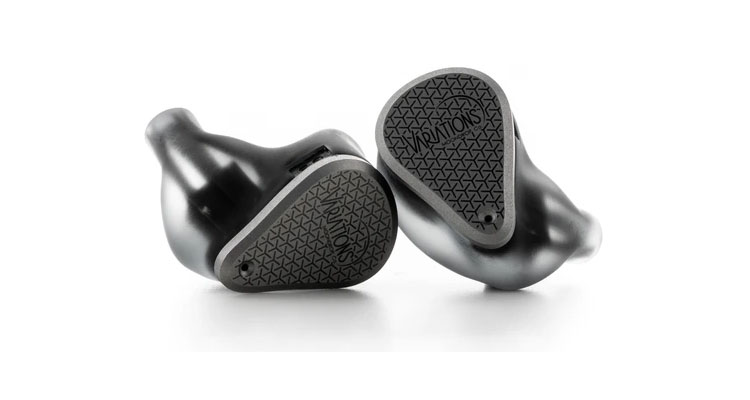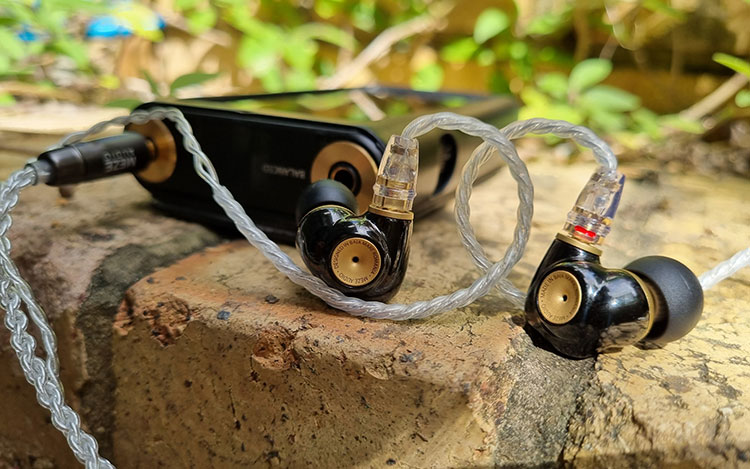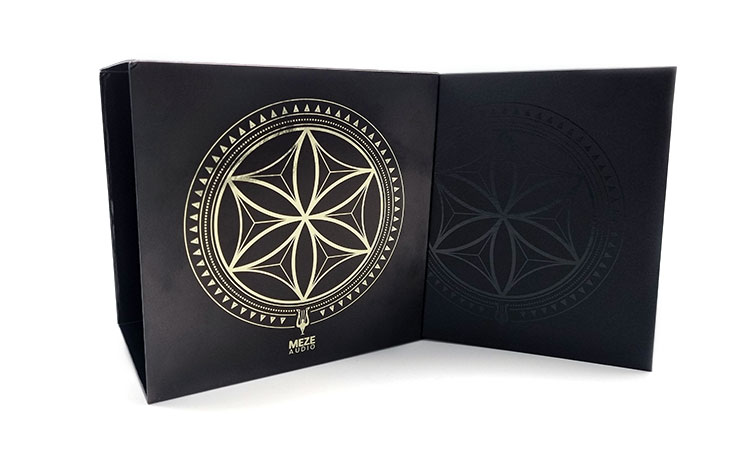Synergy
Efficiency
For this review, I used a Colorfly M1 Dongle DAC/Amp, Sony WM1A, and a Drop Grace SDAC Balanced DAC with an SMSL SH-8S Headphone Amplifier for testing purposes.
The Meze Audio Advar is fairly efficient, with a low, mechanical impedance of 31Ω, and a 111db/mW sensitivity rating. However, unlike its balanced-armature counterparts, it does require a modest volume bump across the board.
Regardless, there was no hiss across each testing rig, nor was there any audible signal noise polluting the chain.
Pairings
Across my testing rigs, the Advar retains its primary sound characteristics, deviating moderately to account for the tech variances between each source/kit.
On the Colorfly M1 Dongle DAC/Amp, its synergy is exemplary. The highly resolving nature of the Advar’s appears cleaner overall, with noticeable clarity across the entire band with a touch of sparkle in the high-frequency band.
The Sony WM1A has a sonic presentation that can be summarised as a gentle, V-shaped frequency response with a scooped-out midrange. As expected, the Sony WM1A deepens Advar’s already W-shaped frequency response.
The Drop Grace SDAC Balanced DAC with an SMSL SH-8S headphone amplifier combination exaggerates the warm overtones and even harmonics that inhabit the low end, creating a Sennheiser-like warmth that clouds out the midrange with a prominent level of haziness.
Overall, the Advar’s mileage is fairly dependent on the source it is paired with. But as long as listeners pair it with a high-quality source, the sonic performance is very good.

Select Comparisons
Moondrop Variations
$520
The Moondrop Variations is a classic, tribrid IEM that succeeded the already-famous Moondrop Blessing.
Technical
The Moondrop Variations has a tribrid array of transducers, including a single, liquid crystal polymer dynamic driver for the low-end, dual Softears-D custom balanced armatures for the midrange, and dual Sonion electrostatic drivers for the highs.
Marketed as the tangible upgrade to the Moondrop Blessing 2, the Variations are simply that, a variation on an already successful theme.
Despite its tribrid topology, its sensitivity rating at 112dB/Vrms @1kH, and mechanical impedance of 15.2 ohms, are substantially lower than its tribrid counterparts. Comparatively, this is a far cry from Advar’s reserved approach to driver architecture.
Design
The Variations feature your standard, run-of-the-mill universal shape we’ve come to love with previous chi-fi releases. However, its aesthetic stylings are far more modern, with its satin-finished, liquid-injection molded resin chassis and a matte finished, aluminum faceplates with a katazome-like pattern sealing it.
Apart from a touch of epoxy leaking from the seam between the faceplate and shell, there are no obvious protrusions are sharp edges to be found. Finishing-wise, the Variations are 100% comparable. However, resin lacks the toughness of steel, losing out to the Advar’s superior build quality.
The Variation’s fit sits largely in my ears, its oblong chassis protruding out of my ears. Nevertheless, I found zero comfort issues with its medium stem and bigger body in a side-by-side comparison with the Advar.
Instead of following Advar’s MMCX standard, the Variations have adopted the ubiquitous 2-pin standard instead. The cables included in the Variations package is a 6NOCC, 2-braided 2-pin cable featuring detachable balanced (2.5mm and 4.4mm) and unbalanced (3.5mm) terminations.
The included cable has a coffee-brown sheen, with excellent flexibility. It’s soft, malleable, and wraps well around the earlobes effortlessly. While it doesn’t display the exceptional malleability of Advar’s SPC cables, the objective differences between them are few and far between in practice.
However, the Variations’ cables and their detachable terminations are an inclusion I wish other competing brands in the IEM space would consider.
Performance
Sonically, both earphones feature many similarities in frequency response, and many contradictions in intangible performance, and practice.
The Variations, similarly, have a gentle V-shaped sound signature with a prominent bass response that emphasizes a deep, enveloping sub-bass rumble over the mid-bass aplomb. Dynamics are livelier, with an aggressive treble response that is exclusive to Sonion electrostatic drivers and its ability to produce incisive highs with speedy transients.
The mid-range performance on both earphones is technically comparable, as it is different in the division between their upper and lower-mid sections. On the Variations, the midrange lacks note weight, while the Advar prioritizes the lower-mid floor modestly.
Staging between the Advar and the Variations are near-identical, with a clean center image and above-average L-R separation between channels.
On the other hand, imaging on the Variations displays the hyper-separating capabilities of tribrid earphones, where the divisions between frequencies translate to outstanding imaging performance at the expense of realism and cohesiveness.
The Advar’s embrace the opposite approach, whilst maintaining exemplary imaging performance given its single-driver architecture.
TinHifi P2 Plus
$620
To celebrate TinHifi’s anniversary, the P2 Plus is the culmination of the brand’s technological innovations and an evolution from the polarizing P2.
Technical
The P2 Plus houses a 12mm planar-magnetic driver similar to its predecessor, the P2. The P2’s notorious low sensitivity is carried over despite attracting much controversy amongst ardent audiophiles. With a sensitivity of 90+/-3dB@1kHz and a mechanical impedance of 32Ω, a powerful source is required for respectable performance.
Design
The P2 Plus has heavily polished, aluminum shells reminiscent of the P2 albeit with an 18K electroplated surface. Similarly, the Advar also features a polished chassis. However, the P2’s gold-plated surface is more prone to fingerprints, and hairline scratches. Furthermore, the Meze-designed shells are weightier, inspiring more confidence in their longevity and build.
The P2 Plus uses a recessed 2-pin, QDC-style connection, unlike the MMCX standard that audiophiles have grown accustomed to. Hence, cable-swapping is not as convenient as the Advar.
The P2 Plus’s included cable is a Mogami 2381 Coaxial cable with interchangeable, balanced (2.5mm and 4.4mm) and unbalanced (3.5mm) terminations.
The cable features speaker-cable-like sheathing, making it difficult to wear comfortably over extended listening sessions. Because of its overly thick braiding, the P2 Plus is more of a “sit down and listen” versus a grab-and-go affair. But as discussed earlier in the previous comparison, the addition of detachable connectors would have sweetened the entire Advar package.
Performance
The P2 Plus is highly resolving, with a frequency response south of neutral. There is a clear sub and mid-bass bump to compensate for complaints raised with the P2’s distinct lack of bass. Conversely, the Advar’s bass response is dynamic and punchy with noteworthy transients, free from midrange bleed.
The P2 Plus upper midrange is a touch more truncated sounding darker than the latter. Highs are clearly more extended on the Advar’s because of its aggressive treble presence. The P2 Plus does not exaggerate the high-frequency band, nor does it downplay its presence significantly.
Soundstage width on both IEMs is similar in performance, and depth between the Z and Y-axis. But the Advar displays a stronger technical grasp at imaging, where the distance between instruments and vocals on the Z-Axis is deeper as it is pronounced, creating a listening environment that fosters ease of identification and comprehension between complex sonic passages.
Our Verdict
The Meze Audio Advar is a powerful, and potent single dynamic driver IEM. This is a full-bodied, unapologetically fun IEM that caters to both sides of the audiophile aisle; the fun-chasers and the clarity-seekers.
The Advar marks a healthy evolution in Meze Audio’s current portfolio of IEMs, cementing itself as a serious contender in the already-saturated IEM marketplace.
If this is a glimpse into the Meze Audio’s foreseeable future, I welcome it with open arms.
Meze Audio Advar Specifications:
- Driver: 10.2mm Dynamic driver
- Frequency Range: 10 Hz – 30 kHz
- Impedance: 31 Ω
- SPL: 111dB/mW
- Distortion: <1% at 1kHz
- Stock cables: MMCX silver-plated cable ending in gold-plated 3.5mm
- Materials: Solid stainless-steel chassis produced by metal injection molding, with CNC finishing
- Finish: High-gloss Black Chrome plating on the main shell





